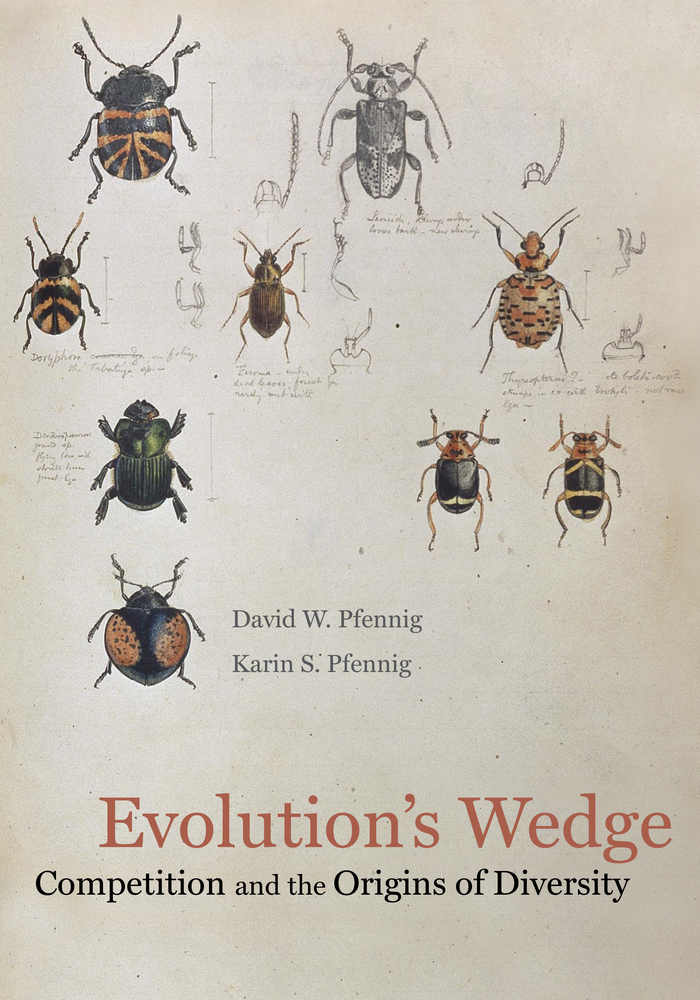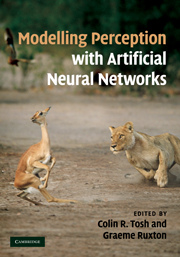Publications
Books & Articles

BOOK
BOOK Pfennig, D. W. and Pfennig, K. S. 2012. Evolution’s Wedge: Competition and the Origins of Diversity. University of California Press, Berkeley, CA.

BOOK Chapter
BOOK Pfennig, K. S. and M. J. Ryan. 2010. Evolutionary diversification of mating behaviour: using artificial neural networks to study reproductive character displacement and speciation. Pages 187-214 in Modeling Perception with Artificial Neural Networks, C. Tosh and G. Ruxton, eds. Cambridge University Press, Cambridge, U.K.
NOTE: PDFs are provided below for non-commercial research and educational use. Not for reproduction, distribution, or commercial use
2020
PDF Chen, C.1 and K. S. Pfennig1. 2020. Females engaging in adaptive hybridization prefer high-quality heterospecifics as mates. Science. 367 (6484): 1377-1379 doi: 10.1126/science.aaz5109. 1Corresponding authors.
PDF Gillespie, R. G. 1, G. M. Bennett, L. De Meester, R. C. Fleischer, L. Harmon, A. Hendry, M. L. Knope, J. Mallet, C. Martin, C. E. Parent, A. H. Patton, K. S. Pfennig, D. Rubinoff, D. Schluter, O. Seehausen, K. Shaw, E. Stacy, M. Stervander, J. T. Stroud, C. Wagner, G. Wogan. 2020. Comparing adaptive radiations across space, time, and taxa. Journal of Heredity 111 (1): 1–20, https://doi.org/10.1093/jhered/esz064. 1Order of authorship after 1st author is alphabetical.
PDF Calabrese, G. M. and K. S. Pfennig1. 2020. Reinforcement and the proliferation of species. Journal of Heredity 111 (1): 138–146, https://doi.org/10.1093/jhered/esz073. 1Corresponding author.
PDF Pfennig, D. W. and K. S. Pfennig. 2020. Quick guide: character displacement. Current Biology 30: R1023–R1024.
2019
PDF Pfennig, K. S. 2019. How to survive in a human-dominated world. Science 364: 433-434. DOI: 10.1126/science.aax3713. PDF of paper is here.
PDF Seidl, F., N. A. Levis, R. Schell,D. W. Pfennig1, K. S. Pfennig1, and I. M. Ehrenreich1. 2019. Genome of Spea multiplicata, a rapidly developing, phenotypically plastic, and desert-adapted spadefoot toad. G3: Genes, Genomes, Genetics; G3: Genes, Genomes, Genetics 9(12): 3909-3919 https://doi.org/10.1534/g3.119.400705. 1Corresponding authors.
PDF Seidl, F.1, N. A. Levis, C. D. Jones, A. Monroy-Eklund, I. M. Ehrenreich2, and K. S. Pfennig1,2. 2019. Variation in hybrid gene expression: implications for the evolution of genetic incompatibilities in interbreeding species. Molecular Ecology 28: 4667– 4679. https://doi.org/10.1111/mec.15246. 1These authors contributed equally to the work. 2Corresponding authors.
PDF Stirman, R. and K. S. Pfennig1. 2019. Competitively mediated changes in male toad calls can depend on call structure. Behavioral Ecology 30(5): 1344-1350 doi:10.1093/beheco/arz085. 1Corresponding author.
PDF Kelly, P. W., D. W. Pfennig, S. D. S. Buzón, and K. S. Pfennig. 2019. Male sexual signal predicts phenotypic plasticity in offspring: implications for the evolution of plasticity and local adaptation. Philosophical Transactions of the Royal Society B: Biological Sciences 374, 20180179.
2017
PDF Burmeister, S. S., V. G. Rodriguez Moncalvo and K. S. Pfennig. 2017. Monoaminergic integration of diet and social signals in the brains of juvenile spadefoot toads. Journal of Experimental Biology jeb.159954 doi: 10.1242/jeb.159954.
PDF Pierce, A. A., R. Gutierrez, A. M. Rice and K. S. Pfennig1. 2017. Genetic variation during range expansion: effects of habitat novelty and hybridization. Proceedings of the Royal Society B – Biological Sciences 284: 20170007. http://dx.doi.org/10.1098/rspb.2017.0007. 1Corresponding author
2016
PDF Pfennig, K. S., A. L. Kelly and A. A. Pierce. 2016. Hybridization as a facilitator of species range expansion. Proceedings of the Royal Society B – Biological Sciences 283: 20161329. http://dx.doi.org/10.1098/rspb.2016.1329.
PDF Pfennig, K. S. 2016. Reinforcement as an initiator of population divergence and speciation. Current Zoology 62: 145–154.
PDF Schmidt, E. M. and K. S. Pfennig. 2016. Hybrid female mate choice as a species isolating mechanism: environment matters. Journal of Evolutionary Biology 29: 865-869.
2015
PDF Garcia, N. W., K. S. Pfennig1, Sabrina S. Burmeister1. 2015. Leptin manipulation reduces appetite and causes a switch in mating preference in the Plains spadefoot toad (Spea bombifrons). PLoS ONE 10(4): e0125981. doi: 10.1371/journal.pone.0125981. 1These authors contributed equally to the work.
PDF Pfennig, K. S., D. W. Pfennig, C. Porter and R. A. Martin. 2015. Sexual selection’s impacts on ecological specialisation: an experimental test. Proceedings of the Royal Society B – Biological Sciences 282: 20150217. doi: 10.1098/rspb.2015.0217.
2014
PDF Pfennig, K. S. and A. M. Rice. 2014. Reinforcement generates reproductive isolation between neighbouring conspecific populations of spadefoot toads. Proceedings of the Royal Society B – Biological Sciences 281: 20140949.
PDF Dhole, S. and K. S. Pfennig. 2014. Age-dependent male mating investment in Drosophila pseudoobscura. PLoS ONE 9(2): e88700. doi:10.1371/journal.pone.0088700
2013
1Abbott, R., D. Albach, S. Ansell, J. W. Arntzen, S. J. E. Baird, N. Bierne, J. Boughman, A. Brelsford, C. A. Buerkle, R. Buggs, R. K. Butlin, U. Dieckmann, F. Eroukhmanoff, A. Grill, S. H. Cahan, J. S. Hermansen, G. Hewitt, A. G. Hudson, C. Jiggins, J. Jones, B. Keller, T. Marczewski, J. Mallet, P. Martinez-Rodriguez, M. Möst, S. Mullen, R. Nichols, A. W. Nolte, C. Parisod, K. Pfennig, A. M. Rice, M. G. Ritchie, B. Seifert, C. M. Smadja, R. Stelkens, J. M. Szymura, R. Vinöl, J. B. W. Wolf and D. Zinner. 2013. Hybridization and speciation. Journal of Evolutionary Biology 26: 229-246. 1Order of authorship is alphabetical.
PDF Pfennig, K. S., V. G. Rodriguez Moncalvo and S. S. Burmeister. 2013. Diet alters species recognition in juvenile toads. Biology Letters 9: 20130599; doi: 10.1098/rsbl.2013.0599
PDF Rodriguez Moncalvo, V. G., S. S. Burmeister and K. S. Pfennig. 2013. Social signals increase monoamine levels in the tegmentum of juvenile Mexican spadefoot toads (Spea multiplicata). Journal of Comparative Physiology – A 199: 681-691.
PDF Wünsch, L. K. and K. S. Pfennig. 2013. Failed sperm development as a reproductive isolating barrier between species. Evolution and Development 15: 458-465.
2012
PDF Bazazi, S., K. S. Pfennig, N. O. Handegard and I. D. Couzin. 2012. Vortex formation and foraging in polyphenic spadefoot toad tadpoles. Behavioral Ecology and Sociobiology 66: 879-889.
PDF Chunco, A. J., T. Jobe and K. S. Pfennig. 2012. Why do species co-occur? A test of alternative hypotheses describing abiotic differences in sympatry versus allopatry using spadefoot toads. PLoS ONE 7(3): e32748. doi:10.1371/journal.pone.0032748.
PDF Leichty, A. R., D. W. Pfennig, C. D. Jones and K. S. Pfennig. 2012. Relaxed genetic constraint is ancestral to the evolution of phenotypic plasticity. Integrative and Comparative Biology 52: 16-30.
PDF Pfennig, D. W. and K. S. Pfennig. 2012. Development and evolution of character displacement. The Year in Evolutionary Biology-2011: Annals of the N.Y. Academy of Sciences 1256: 89–107.
PDF Pfennig, K. S., A. Allenby, R. A. Martin, A. Monroy and C. D. Jones. 2012. A suite of molecular markers for identifying species, detecting introgression and describing population structure in spadefoot toads (Spea spp.). Molecular Ecology Resources 12: 909-917.
PDF Pfennig, K. S. and A. H. Hurlbert. 2012. Heterospecific interactions and the proliferation of sexually dimorphic traits. Current Zoology 58: 453-462.
2011
PDF Pfennig, K. S. and A. B. Stewart. 2011. Asymmetric reproductive character displacement in male aggregation behavior. Proceedings of the Royal Society B – Biological Sciences 278: 2348-2354.
2010
PDF Pfennig, D. W. and K. S. Pfennig. 2010. Character displacement and the origins of diversity. American Naturalist 176: S26-S44.
2009
PDF Pfennig, K. S. and D. W. Pfennig. 2009. Character displacement: ecological and reproductive responses to a common evolutionary problem. The Quarterly Review of Biology 84: 253-276.
2008
PDF Pfennig, K. S. 2008. Population differences in condition-dependent sexual selection may promote divergence in non-sexual traits. Evolutionary Ecology Research 10: 763-773.
PDF Rice, A. M., D. E. Pearse, T. Becker, R. A. Newman, C. Lebonville, G. R. Harper and K. S. Pfennig. 2008. Development and characterization of nine polymorphic microsatellite markers for Mexican spadefoot toads (Spea multiplicata) with cross-amplification in Plains spadefoot toads (S. bombifrons). Molecular Ecology Resources 8: 1386-1389.
2007
PDF Pfennig, K. S. 2007. Facultative mate choice drives adaptive hybridization. Science 318: 965-967.
PDF Pfennig, K. S., A. J. Chunco and A. C. R. Lackey. 2007. Ecological selection and hybrid fitness: hybrids succeed on parental resources. Evolutionary Ecology Research 9: 341-354.
PDF Pfennig, K. S. and M. J. Ryan. 2007. Character displacement and the evolution of mate choice: an artificial neural network approach. Philosophical Transactions of the Royal Society B – Biological Sciences 362: 411-419.
PDF Pfennig, D. W., G. R. Harper, Jr., A. F. Brumo, W. R. Harcombe and K. S. Pfennig. 2007. Population differences in predation on Batesian mimics in allopatry with their model: selection against mimics is strongest when they are common. Behavioral Ecology and Sociobiology 61: 505-511.
PDF Vásquez, T. and K. S. Pfennig. 2007. Looking on the bright side: females prefer coloration indicative of male size and condition in the sexually dichromatic spadefoot toad, Scaphiopus couchii. Behavioral Ecology and Sociobiology 62: 127-135.
2006
PDF Pfennig, K. S. and M. J. Ryan. 2006. Reproductive character displacement generates reproductive isolation among conspecific populations: an artificial neural network study. Proceedings of the Royal Society B – Biological Sciences 273: 1361-1368.
2005
PDF Pfennig, K. S. and D. W. Pfennig. 2005. Character displacement as the “best of a bad situation”: fitness trade-offs resulting from selection to minimize resource and mate competition. Evolution 59: 2200-2208.
2003
PDF Pfennig, K. S. 2003. A test of alternative hypotheses for the evolution of reproductive isolation between spadefoot toads: support for the reinforcement hypothesis. Evolution 57: 2842-2851.
2002
PDF Pfennig, K. S. and M. A. Simovich. 2002. Differential selection to avoid hybridization in two toad species. Evolution 56: 1840-1848.
PDF Pfennig, K. S. and R. C. Tinsley. 2002. Different mate preferences by parasitized and unparasitized females potentially reduces sexual selection. Journal of Evolutionary Biology 15: 399-406.
2001
PDF Pfennig, K. S. 2001. Evolution of pathogen virulence: the role of variation in host phenotype. Proceedings of the Royal Society of London Series B – Biological Sciences 268: 755-760.
PDF Pfennig, D. W., W. R. Harcombe and K. S. Pfennig. 2001. Frequency-dependent Batesian mimicry. Nature 410: 323.
2000
PDF Pfennig, K. S. 2000. Female spadefoot toads compromise on mate quality to ensure conspecific matings. Behavioral Ecology 11: 220-227.
PDF Pfennig, K. S., K. Rapa and R. McNatt. 2000. Evolution of male mating behavior: male spadefoot toads preferentially associate with conspecific males. Behavioral Ecology and Sociobiology 48: 69-74.
1998
PDF Pfennig, K. S. 1998. The evolution of mate choice and the potential for conflict between species and mate-quality recognition. Proceedings of the Royal Society of London Series B – Biological Sciences 265: 1743-1748.
1997
PDF Pfennig, K. S. and J. K. Conner. 1997. Pollen limitation in an experimental population of the wild radish Raphanus raphanistrum. Canadian Journal of Botany 75: 72-73.
PDF Suarez, A. V., K. S. Pfennig and S. K. Robinson. 1997. Nesting success of a disturbance-dependent songbird on different kinds of edges. Conservation Biology 11: 928-935.

